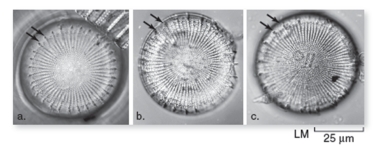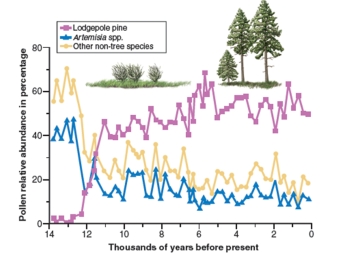A) A protozoa
B) An algae
C) A slime mold
D) A diatom
E) An apicomplexan
G) A) and C)
Correct Answer

verified
Correct Answer
verified
Multiple Choice
Silica walls are characteristic of:
A) Diatoms
B) Euglenoids
C) Red algae
D) Brown algae
E) Slime molds
G) All of the above
Correct Answer

verified
Correct Answer
verified
Multiple Choice
The largest algae are:
A) Kelp
B) Diatoms
C) Red algae
D) Golden algae
E) Green algae
G) A) and B)
Correct Answer

verified
Correct Answer
verified
Multiple Choice
Figure 17.21  -In Figure 17.21,the authors show pictures of the modern diatoms S.niagarae (a) and S.yellowstonensis (c) as well as a transitional fossil.Which modern species does the transitional fossil most resemble?
-In Figure 17.21,the authors show pictures of the modern diatoms S.niagarae (a) and S.yellowstonensis (c) as well as a transitional fossil.Which modern species does the transitional fossil most resemble?
A) S. yellowstonensis
B) S. niagarae
BLOOM'S LEVEL: 4. Analyze
LEARNING OUTCOME: 12.04.01 Compare and contrast homologous, analogous, and vestigial structures.LEARNING OUTCOME: 17.02.01 Describe the characteristics of euglenoid and dinoflagellate protists.SECTION: 12.04
SECTION: 17.06
TOPIC: Evolution-Speciation
TOPIC: Investigating Life
TOPIC: Protists
D) undefined
Correct Answer

verified
Correct Answer
verified
Multiple Choice
Sponges:
A) Are the simplest animals
B) Are plants
C) Are the most complex protists
D) Are prokaryotic bacteria
E) Are not alive
G) C) and D)
Correct Answer

verified
Correct Answer
verified
Multiple Choice
figure 17.20  -In figure 17.20,the plant community changed from alpine tundra grasses to coniferous forest as temperatures warmed up.In this figure lodgepole pines are occupying which of the following?
-In figure 17.20,the plant community changed from alpine tundra grasses to coniferous forest as temperatures warmed up.In this figure lodgepole pines are occupying which of the following?
A) A realized niche
B) A community
C) A population
D) A fundamental niche
E) A biome
G) C) and D)
Correct Answer

verified
Correct Answer
verified
Multiple Choice
Chloroplasts in algae are thought to have arisen from which source?
A) Cyanobacteria
B) Aerobic bacteria
C) Anaerobic bacteria
D) Photosynthetic viruses
E) Aerobic fungi
G) All of the above
Correct Answer

verified
Correct Answer
verified
True/False
A dinoflagellate has both a transverse flagellum and longitudinal flagellum.
B) False
Correct Answer

verified
Correct Answer
verified
True/False
All protists are single-celled.
B) False
Correct Answer

verified
Correct Answer
verified
True/False
Alternation of generations means having alternating multicelled haploid and diploid phases in a life cycle.
B) False
Correct Answer

verified
Correct Answer
verified
Multiple Choice
In malaria,Plasmodium falciparum grow inside of human cells.As such they are which of the following?
A) Autotrophs
B) Heterotrophs
C) Phototrophs
D) Heterotrophs and autotrophs
E) Autotrophs and phototrophs
G) All of the above
Correct Answer

verified
Correct Answer
verified
Multiple Choice
Dictyostelium discoideum is an unusual organism,one that straddles the boundary between the unicellular and the multicellular.Its feeding phase consists of individual amoeba-like cells that move independently,feeding on bacteria by phagocytosis.When the food runs out,cells begin to aggregate into a multicelled structure that migrates toward light.The cells differentiate into a base,stalk,and spores; only the spores survive to colonize a new habitat.What is the advantage of forming spores?
A) The spores will eat the other cells
B) The spores are photosynthetic
C) Spores are smaller and can be transported to new habitats
D) Spores can mate with other species
E) Spores have flagella and can swim to new habitats
G) A) and D)
Correct Answer

verified
Correct Answer
verified
Multiple Choice
How might global climate change affect the distribution of malaria?
A) By expanding the range of Plasmodium falciparum
B) By allowing more people to live in areas where malaria already occurs
C) By increasing the number of Plasmodium falciparum in each mosquito
D) By expanding the range of the mosquito
E) By increasing how fast Plasmodium falciparum grows inside human red blood cells
G) A) and D)
Correct Answer

verified
Correct Answer
verified
Multiple Choice
The engulfment of food particles by a cell is:
A) Chemotaxis
B) Organotaxis
C) Pseudopodia
D) Cytokinesis
E) Phagocytosis
G) A) and C)
Correct Answer

verified
Correct Answer
verified
Multiple Choice
Euglena and dinoflagellates have chloroplasts and flagella.This means they are which of the following?
A) Photosynthetic
B) Mobile
C) Multicellular
D) Photosynthetic and mobile
E) Multicellular and mobile
G) B) and C)
Correct Answer

verified
Correct Answer
verified
Multiple Choice
African sleeping sickness is caused by Trypanosoma brucei,a unicellular flagellated protist infects red blood cells after being injected into the blood stream.African sleeping sickness is transmitted by:
A) Ingesting food
B) Contaminated water
C) Sexual intercourse
D) The bite of an insect
E) Exhaled aerosols
G) A) and C)
Correct Answer

verified
Correct Answer
verified
Multiple Choice
Cytoplasmic extensions by which some protozoa move are:
A) Cilia
B) Flagella
C) Pseudopodia
D) Axial filaments
E) Pili
G) D) and E)
Correct Answer

verified
Correct Answer
verified
Multiple Choice
The microscopic food that supports the ocean's vast food webs is:
A) Coral
B) Plankton
C) Jellyfish
D) Organic compounds released by thermal vents in the ocean floor
E) Bacteria only
G) A) and E)
Correct Answer

verified
Correct Answer
verified
True/False
The movement toward a chemical stimulus is called cytokinesis.
B) False
Correct Answer

verified
Correct Answer
verified
Multiple Choice
Cryptosporidium is an apicomplexian that can contaminate water supplies.Which of the following would you predict to be the case of a Cryptosporidium outbreak?
A) It can only be transmitted by insect bites because it is nonmotile
B) It can grow in any water supply because it is photosynthetic
C) It will be difficult to treat with chlorine because it forms spores
D) It spreads rapidly because it has flagella
E) It will enter a person's body through their respiratory tract
G) All of the above
Correct Answer

verified
Correct Answer
verified
Showing 21 - 40 of 59
Related Exams